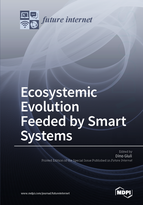Ecosystemic Evolution Feeded by Smart Systems
A special issue of Future Internet (ISSN 1999-5903).
Deadline for manuscript submissions: closed (29 February 2016) | Viewed by 80485
Special Issue Editor
Interests: information society; smart cities; e-government; e-mobility; smart mission critical systems; remote-sensing systems
Special Issues, Collections and Topics in MDPI journals
Special Issue Information
Information Society is advancing along a route of ecosystemic evolution. ICT and Internet advancements, as well as progression of the systemic approach for enhancement and application of Smart Systems, are grounding such an evolution. Such an approach is expected to evolve while fitting into the basic requirements of a significant general enhancement of human and social well-being, in all the life spheres (public, private, professional). This corresponds to enhancing and exploiting the Net-Living virtual space to make it a virtuous and effectively widely beneficial extension of the real-life space. Meanwhile, contextual evolution of Smart Cities is aimed at strongly empowering that ecosystemic approach by enhancing and extending Net-Living benefits over our own lived territory, while also incisively targeting a new stable socio-economic territorial development, according to social-ecological and economical sustainability requirements. This territorial focus matches with a glo-cal vision, which enables a more effective diffusion of benefits in terms of well-being, thus moderating a global vision that is primarily linked to global-scale market developments.
Basic technological-advancements have to be pursued at the system-level. They include system architecting for virtualization of functions, flexible basic service composition, and end-service personalization viability, for the operation and interoperation of Smart Systems, supporting effective Net-Living advancements in different application fields.
Increasing, and basically mandatory, importance must also be reserved for human-technical and socio-technical factors, as well as to the associated need of empowering the cross-disciplinary approach for related research and innovation. The prospected eco-systemic impact also implies a social pro-active participation, as well as coping with possible negative effects of Net-Living in terms of social exclusion and isolation, which also require incisive actions for conformal socio-cultural development. In this, speed, continuity, and expected long-term duration of innovation processes, pushed by basic technological advancements, make related requirements stricter. Therefore, it is also quite important to develop a new approach, targeting development of basic and vocational education for Net-Living, which is to be considered as an engine for the development of the related “New Living Know-How”, as well as of the conformal “New Making Know-How”.
Furthermore, increasing importance of an approach in terms of ”Translational Research”, to enable short and proficient circuits to continuously address and exploit valuable research advancements, by also involving different actors, as purposely and pro-actively, is needed (Open Net-Living Labs).
Scientific contributions to this Special Issue are expected in order to enrich the above-mentioned eco-systemic view, while providing specific original and valuable results of pertaining research.
Prof. Dr. Dino Giuli
Guest Editor
Manuscript Submission Information
Manuscripts should be submitted online at www.mdpi.com by registering and logging in to this website. Once you are registered, click here to go to the submission form. Manuscripts can be submitted until the deadline. All submissions that pass pre-check are peer-reviewed. Accepted papers will be published continuously in the journal (as soon as accepted) and will be listed together on the special issue website. Research articles, review articles as well as short communications are invited. For planned papers, a title and short abstract (about 100 words) can be sent to the Editorial Office for announcement on this website.
Submitted manuscripts should not have been published previously, nor be under consideration for publication elsewhere (except conference proceedings papers). All manuscripts are thoroughly refereed through a single-blind peer-review process. A guide for authors and other relevant information for submission of manuscripts is available on the Instructions for Authors page. Future Internet is an international peer-reviewed open access monthly journal published by MDPI.
Please visit the Instructions for Authors page before submitting a manuscript. The Article Processing Charge (APC) for publication in this open access journal is 1600 CHF (Swiss Francs). Submitted papers should be well formatted and use good English. Authors may use MDPI's English editing service prior to publication or during author revisions.
Keywords
- Information Society
- Smart Cities
- Smart Infrastructural Utilities
- Smart Enterprise and Manufacturing
- E-Citizenship Service
- Smart Liveability of Human Habitats
- Smart Communities
- Smart Health and Social Assistance Systems
- Human-Technical Factors
- Socio-Technical Factors
- Basic and Vocational Education for Net-Living
- Net-Living Labs






